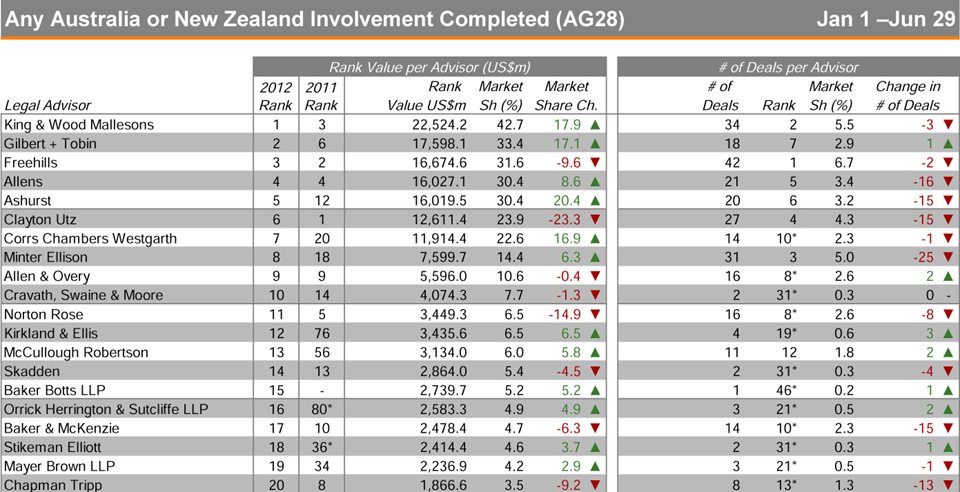Oz worst hit in M&A drop
Australian M&A activity has plunged more than 50 per cent in the first half (H1) of 2012 compared to the same period last year, according to a recent M&A review.

Thomson Reuters found Australian H1 M&A activity amounted to $US49.1 billion, down from $US98.4 billion in H1 of 2011.
Elsewhere, a Mergermarket analysis found that Australia, which has been hit by falling commodity prices, recorded a 22.3 per cent fall this half, compared to H1 2011; the biggest year-on-year decline of any country in the Asia-Pacific region.
Mergermarket’s data is based on transactions of more than $US5m announced between 1 January 2012 and 30 June 2012.
Freehills topped Reuters’ H1 roundup, with both the highest value and number of announced deals, followed by King & Wood Mallesons (KWM), which also scored the highest value of completed deals.

Freehills has this year advised Austar on its merger with Foxtel; AGL Energy on its acquisition of the Loy Yang Power Station, and Yanzhou Coal on its merger with Gloucester Coal, but traditional M&A activity remains sluggish, according to Freehills partner Rebecca Maslen-Stannage (pictured).
“The Australian M&A market never sleeps, it just changes form as the market changes. In the first half of this year, developments included new market entrants, calls for de-mergers and a rise in shareholder activism,” said Maslen-Stannage.
Maslen-Stannage said all eyes were currently focused on the potential de-merger of News Corp, to separate the company’s publishing and entertainment arms.
“We are seeing shareholders call for de-mergers where there is a perception that a company will be more valuable following a separation of assets. As when private equity did that successfully before the GFC, shareholders are asking whether the companies in which they are invested should pre-empt that by demerging themselves,” said Maslen-Stannage.
“For the right company a de-merger can work, but you need the right set of assets and conditions – in some cases the separation costs and stamp duty can outweigh the benefits.”
Energetic exception
M&A activity with Asian involvement also fell to $US205.2 billion in H1, although this was only a 5.9 per cent decline from H1 2011, according to Reuters.
Companies in the materials sector were the most targeted, with $US41 billion from 664 deals, while 296 deals in the energy and power sector amounted to $US28.5 billion.
Outbound volume reached $US18.1 billion, a 16.7 per cent increase from last year, with $US6.7 billion invested in energy and power.
Maslen-Stannage believes there has been a slowdown, however, in big energy and resources deals, specifically in terms of consolidation between coal companies.
“The drop in coal prices has created a shift in the market, making consolidation in the energy and resources sector less active,” she said.
Worldwide, M&A activity totalled $US1.1 trillion during H1 2012, a 22 per cent decrease from comparable 2011 levels.
Cross-border M&A, which accounted for 42 per cent of overall M&A volume in H1 2012, was driven by the energy & power (18%), consumer staples, materials (13%) and financial (11%) sectors.
Media and entertainment and consumer products deals led the decliners, down 46 per cent and 45 per cent respectively.
M&A activity with Asian involvement also fell to $US205.2 billion in H1, although this was only a 5.9 per cent decline from H1 2011, according to Reuters.
Companies in the materials sector were the most targeted, with $US41 billion from 664 deals, while 296 deals in the energy and power sector amounted to $US28.5 billion.
Outbound volume reached $US18.1 billion, a 16.7 per cent increase from last year, with $US6.7 billion invested in energy and power.
Maslen-Stannage believes there has been a slowdown, however, in big energy and resources deals, specifically in terms of consolidation between coal companies.
“The drop in coal prices has created a shift in the market, making consolidation in the energy and resources sector less active,” she said.
Worldwide, M&A activity totalled $US1.1 trillion during H1 2012, a 22 per cent decrease from comparable 2011 levels.
Cross-border M&A, which accounted for 42 per cent of overall M&A volume in H1 2012, was driven by the energy & power (18%), consumer staples, materials (13%) and financial (11%) sectors.
Media and entertainment and consumer products deals led the decliners, down 46 per cent and 45 per cent respectively.